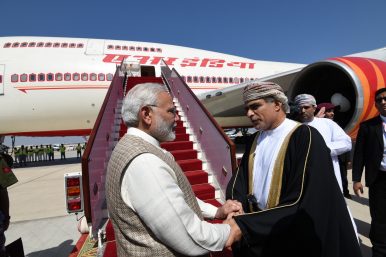By Harsh V. Pant
 India is still stuck in the age-old debates of the Israel-Arab rivalry whereas the Middle East has moved on. Can Modi change that?
India is still stuck in the age-old debates of the Israel-Arab rivalry whereas the Middle East has moved on. Can Modi change that?
As India seeks to pursue multi-dimensional engagement with the Middle East, Prime Minister Narendra Modi’s latest visit to the region has merely underscored the growing salience of the region in the Indian foreign policy matrix. While a lot of focus is often given to India’s ‘Act East’ policy, India’s ‘Look West’ policy too has evolved rapidly. This was Modi’s fifth visit to West Asia in the last three and a half years and sustained high-level engagement has ensured that India’s voice is becoming an important one in a region that is witnessing major power rivalries playing out in the open like never before.
Coming just weeks after Israeli Prime Minister Benjamin Netanyahu’s high profile visit to India, Modi’s engagement with Palestine — the first ever visit by an Indian prime minister — was viewed with significant interest. Underlining India’s credentials as a “very respected country in the international arena,” Palestinian President Mahmoud Abbas called for a potential Indian role in the Middle Eastern peace process. “We believe in the importance of a possible Indian role to reach a final agreement based on international consensus and resolutions,” President Abbas had suggested before Modi’s visit. Modi decided to steer clear of this as the complexities of the region were evident in the very manner of Modi’s landing at the Palestinian Authority’s presidential headquarters in Ramallah, in a chopper provided by the Jordanian government, escorted by choppers from the Israel Air Force.
In line with New Delhi’s policy of trying to build capacity of Palestine, India signed six agreements worth around $50 million with the Palestinian Authority that includes the setting up of a $30 million super specialty hospital in Beit Sahur, a center for empowering women, the procurement of equipment and machinery for the National Printing Press, and significant investment in the education sector. To promote ties between India and Palestine, Abbas also conferred the ‘Grand Collar of the State of Palestine’ on Modi. Though Modi said India hopes for Palestine to soon emerge a sovereign and independent country in a peaceful environment through dialogue, he departed from the past practice by dropping any mention of a “united” and “viable” Palestine in his remarks. Urging the two sides to move away from “violence and baggage of the past,” Modi’s shift is as much about changing realities on the ground as about New Delhi’s evolving priorities.
India’s robust engagements with the Arab Gulf states are part of this dynamic too, with Modi visiting the United Arab Emirates for the second time in the last three years. Trade and economic ties are becoming central to the India-UAE relationship. The two sides signed a landmark pact awarding a consortium of Indian oil companies a 10 percent stake in an offshore oil concession that will be the first Indian investment in the upstream oil sector of the UAE. It will go a long way in transforming a traditional buyer-seller relationship to a long-term investor relationship with stakes in each other’s strategic sectors. Keeping the Indian workforce in mind, India and the UAE signed an MoU that aims to institutionalize the collaborative administration of contractual employment of Indian workers. In their joint statement, India and the UAE “reiterated their condemnation for efforts, including by States, to use religion to justify, support and sponsor terrorism against other countries, or to use terrorism as instrument of State policy.” A growing convergence is emerging between India and the UAE in tackling terrorism, which India has been successful in tapping into with an eye on Pakistan.
Oman has been a longstanding partner of India in the Middle East too, where Indians constitute the largest expatriate community. With the Indian Ocean becoming a priority focus area of New Delhi, Oman’s significance is only likely to grow. China’s expanding footprint in the Indian Ocean region has alerted India to the possibility of strengthening security ties with littoral states. India is likely to step up its military presence in Oman. Naval cooperation with Oman has already been gaining momentum with Muscat giving birthing rights to Indian naval vessels to fight piracy in the Gulf of Aden. Regular naval exercises have now become the norm.
India and Oman not only made their military cooperation more expansive during Modi’s visit, but also made an attempt to take the relationship to other domains by enhancing cooperation in the field of health, tourism, and peaceful uses of outer space.
Given the nature of the Middle East’s polities, where sultans and monarchs still reign, Modi personal diplomacy has indeed had a significant impact in galvanizing bilateral relations. But bureaucratic inertia In New Delhi continues to hamper India’s outreach. India’s engagement with the Middle East should now focus on delivering on its commitments and strengthening its presence as an economic and security partner. This will be crucial as traditional powers like the United States and Russia are busy in militarily jostling with each other even as U.S. stakes in the region are declining by the day. China and India, as two emerging powers, are yet to articulate a clear road map for the region. India is still stuck in the age-old debates of the Israel-Arab rivalry, whereas the Middle East has moved on. Growing rivalry between Sunni Arabs and Shia Iran is reshaping old relationships. India will have to be more pragmatic in its approach towards the region and junk old shibboleths. In the end, Modi’s visit underlined this new reality for India.
No comments:
Post a Comment